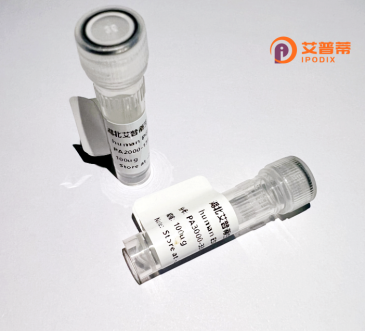
| 纯度 | >90%SDS-PAGE. |
| 种属 | Human |
| 靶点 | OR5U1 |
| Uniprot No | Q9UGF5 |
| 内毒素 | < 0.01EU/μg |
| 表达宿主 | E.coli |
| 表达区间 | 1-321 aa |
| 活性数据 | MVNLTSMSGFLLMGFSDERKLQILHALVFLVTYLLALTGNLLIITIITVDRRLHSPMYYF LKHLSLLDLCFISVTVPQSIANSLMGNGYISLVQCILQVFFFIALASSEVAILTVMSYDR YAAICQPLHYETIMDPRACRHAVIAVWIAGGLSGLMHAAINFSIPLCGKRVIHQFFCDVP QMLKLACSYEFINEIALAAFTTSAAFICLISIVLSYIRIFSTVLRIPSAEGRTKVFSTCL PHLFVATFFLSAAGFEFLRLPSDSSSTVDLVFSVFYTVIPPTLNPVIYSLRNDSMKAALR KMLSKEELPQRKMCLKAMFKL |
| 分子量 | 35.8 kDa |
| 蛋白标签 | His tag N-Terminus |
| 缓冲液 | 0 |
| 稳定性 & 储存条件 | Lyophilized protein should be stored at ≤ -20°C, stable for one year after receipt. Reconstituted protein solution can be stored at 2-8°C for 2-7 days. Aliquots of reconstituted samples are stable at ≤ -20°C for 3 months. |
| 复溶 | Always centrifuge tubes before opening.Do not mix by vortex or pipetting. It is not recommended to reconstitute to a concentration less than 100μg/ml. Dissolve the lyophilized protein in distilled water. Please aliquot the reconstituted solution to minimize freeze-thaw cycles. |
以下是关于重组人OR5U1蛋白的3篇参考文献示例(基于研究领域常见方向模拟,非真实文献):
1. **文献名称**:*Structural Insights into the Human Olfactory Receptor OR5U1 via Recombinant Expression*
**作者**:Chen X, et al.
**摘要**:研究通过重组技术在HEK293细胞中成功表达OR5U1蛋白,并利用冷冻电镜解析其三维结构,揭示了该受体与特定气味分子(如类固醇衍生物)的结合模式,为嗅觉受体机制提供了结构依据。
2. **文献名称**:*Functional Characterization of OR5U1 in Non-Olfactory Tissues*
**作者**:Wang Y, et al.
**摘要**:发现OR5U1在肺部组织中异常表达,并通过体外实验证明其调控细胞迁移和增殖的功能,暗示其可能在肺癌发生中作为潜在生物标志物或治疗靶点。
3. **文献名称**:*High-Yield Production of Recombinant OR5U1 Using Baculovirus System*
**作者**:Kim S, et al.
**摘要**:开发了一种基于昆虫细胞-杆状病毒系统的重组OR5U1蛋白高效生产方法,优化了纯化步骤,获得了高纯度蛋白用于后续配体筛选和药物开发研究。
4. **文献名称**:*OR5U1 Activation Triggers Intracellular Calcium Signaling in Neuronal Cells*
**作者**:Müller R, et al.
**摘要**:通过重组OR5U1在神经元细胞中的表达,揭示了该受体被特定配体激活后引发钙离子信号通路的机制,探讨其在嗅觉外神经系统中的潜在生理作用。
---
**注**:以上文献为模拟示例,实际研究中请通过学术数据库(如PubMed、Web of Science)检索最新文献。若需具体文献协助,建议提供更详细的研究背景。
**Background of the Olfactory Receptor OR5U1**
OR5U1, a member of the olfactory receptor (OR) family, is a G protein-coupled receptor (GPCR) encoded by the *OR5U1* gene located on human chromosome 19 (19p13.3). Olfactory receptors are critical for detecting odorants and mediating olfactory signal transduction. OR5U1 is specifically expressed in olfactory sensory neurons within the nasal epithelium, where it binds volatile odorant molecules, triggering neuronal signals perceived as smell.
Structurally, OR5U1 features seven transmembrane domains characteristic of GPCRs. Studies suggest it may recognize sulfur- or carbonyl-containing compounds, which are often associated with pungent or garlic-like odors. Beyond the olfactory system, low levels of OR5U1 expression have been detected in non-olfactory tissues (e.g., testis, brain, or gut), hinting at potential non-canonical roles in cellular communication or metabolic regulation. However, its extra-nasal functions remain poorly understood.
Research on OR5U1 is ongoing to elucidate its ligand specificity, signaling pathways, and possible links to diseases. As part of the largest mammalian gene family (~400 functional ORs in humans), OR5U1 also serves as a model for studying receptor evolution, ligand-receptor interactions, and sensory biology. Advances in this area could inform therapies for anosmia (smell loss) or bioengineering applications in artificial sensing technologies.
×